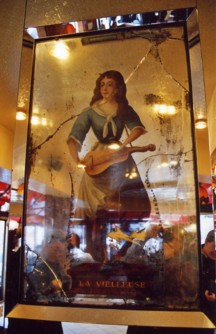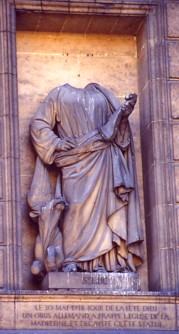The
hurdy-gurdy player
19th
arrondissement - corner rue de Belleville/Blvd.
de Belleville
 The
rue de Belleville, which runs down from the Porte des Lilas, marks the border
between the 19th and 20th arrondissements. The meeting of the Boulevard de Villette
(19th arrondissement), the rue de Belleville, the Boulevard de Belleville (20th
arrondissement) and the rue du Faubourg du Temple (10-11th arrondissement) formed
the limit between Paris city and its suburbs until 1860. Up until then - and
after - Rue de Belleville, being outside the city limits, was the venue for
some of the most disreputable guingettes selling tax-exempt alcohol that
ringed the French capital.
The
rue de Belleville, which runs down from the Porte des Lilas, marks the border
between the 19th and 20th arrondissements. The meeting of the Boulevard de Villette
(19th arrondissement), the rue de Belleville, the Boulevard de Belleville (20th
arrondissement) and the rue du Faubourg du Temple (10-11th arrondissement) formed
the limit between Paris city and its suburbs until 1860. Up until then - and
after - Rue de Belleville, being outside the city limits, was the venue for
some of the most disreputable guingettes selling tax-exempt alcohol that
ringed the French capital.
Two famous cafés guarded the entrance
to the rue Belleville before it climbed north-eastwards: Au Point du Jour
and La Vielleuse. Au Point du Jour has gone (like much of this
area's European population), to be replaced by an anonymous office building,
while La Vielleuse remains (staffed and frequented largely by North Africans).
During the Commune of 1870-1871,
La Vielleuse (which is really in the 20th arrondissement - we're cheating
again) was used as a meeting place for les clubs rouges, revolutionary
groups of different hues of red. Here are part of the minutes from a meeting
held on February 2, 1871 : .... "The socialist democracy of Belleville holds
its electoral meeting at La Vielleuse. The public is more numerous and
more tumultuous than ever. The candidates are all reviewed, and Victor Hugo
comes under examination. One speaker agrees that Victor Hugo has served democracy
well by standing on his small island rock [Hugo was in exil on Guernsey
at the time] for the past 20 years as a living protest against the empire
(some applause); but Victor Hugo is not one of us. ("Right enough! He's
a toff"). He belongs to the bourgeoisie. ("We don't need them!")
He's a man of the past, what we need are men of the future. (General signs of
agreement). Victor Hugo's candidacy is put to the vote and unanimously rejected.
(Applause)". The Communards built a huge barricade at the crossroads outside
La Vielleuse to defend this traditionally working-class area, but it
was swiftly brushed aside during the Semaine sanglante that put an end
to Paris self-rule in May 1871.
 La
Vielleuse (which means "the female hurdy-gurdy player") was to suffer further
outrages of fortune in June 1918, when shrapnel from a shell fired by the giant
German cannon called Groß Bertha situated over 100km away managed to crack a
mirror containing precisely an image of La Vielleuse. The cracked mirror
(above) has been religiously conserved since then, with the following
defiant words painted above it: "Malgré Bertha qui la blessa le 9 juin 1918,
elle n'a jamais cessé de jouer l'hymne de la victoire." The damage
wrought by Groß Bertha is commemorated elsewhere in Paris, notably in the courtyard
of Charlemagne college in the Marais, which was struck by a shell around the
same time, and at Madeleine church in the 8th arrondissement, where Saint-Luke
remains headless since being hit by shrapnel on May 30, 1918 (see photo left).
Much greater carnage was caused at Saint-Gervais church, behind the Hôtel de
Ville, which took a direct hit during Mass on Good Friday on March 29, 1918.
Casualties came to 77 dead and 91 wounded.
La
Vielleuse (which means "the female hurdy-gurdy player") was to suffer further
outrages of fortune in June 1918, when shrapnel from a shell fired by the giant
German cannon called Groß Bertha situated over 100km away managed to crack a
mirror containing precisely an image of La Vielleuse. The cracked mirror
(above) has been religiously conserved since then, with the following
defiant words painted above it: "Malgré Bertha qui la blessa le 9 juin 1918,
elle n'a jamais cessé de jouer l'hymne de la victoire." The damage
wrought by Groß Bertha is commemorated elsewhere in Paris, notably in the courtyard
of Charlemagne college in the Marais, which was struck by a shell around the
same time, and at Madeleine church in the 8th arrondissement, where Saint-Luke
remains headless since being hit by shrapnel on May 30, 1918 (see photo left).
Much greater carnage was caused at Saint-Gervais church, behind the Hôtel de
Ville, which took a direct hit during Mass on Good Friday on March 29, 1918.
Casualties came to 77 dead and 91 wounded.
 Return
to home page
Return
to home page  To
top of the page
To
top of the page
 The
rue de Belleville, which runs down from the Porte des Lilas, marks the border
between the 19th and 20th arrondissements. The meeting of the Boulevard de Villette
(19th arrondissement), the rue de Belleville, the Boulevard de Belleville (20th
arrondissement) and the rue du Faubourg du Temple (10-11th arrondissement) formed
the limit between Paris city and its suburbs until 1860. Up until then - and
after - Rue de Belleville, being outside the city limits, was the venue for
some of the most disreputable guingettes selling tax-exempt alcohol that
ringed the French capital.
The
rue de Belleville, which runs down from the Porte des Lilas, marks the border
between the 19th and 20th arrondissements. The meeting of the Boulevard de Villette
(19th arrondissement), the rue de Belleville, the Boulevard de Belleville (20th
arrondissement) and the rue du Faubourg du Temple (10-11th arrondissement) formed
the limit between Paris city and its suburbs until 1860. Up until then - and
after - Rue de Belleville, being outside the city limits, was the venue for
some of the most disreputable guingettes selling tax-exempt alcohol that
ringed the French capital.  La
Vielleuse (which means "the female hurdy-gurdy player") was to suffer further
outrages of fortune in June 1918, when shrapnel from a shell fired by the giant
German cannon called Groß Bertha situated over 100km away managed to crack a
mirror containing precisely an image of La Vielleuse. The cracked mirror
(above) has been religiously conserved since then, with the following
defiant words painted above it: "Malgré Bertha qui la blessa le 9 juin 1918,
elle n'a jamais cessé de jouer l'hymne de la victoire." The damage
wrought by Groß Bertha is commemorated elsewhere in Paris, notably in the courtyard
of Charlemagne college in the Marais, which was struck by a shell around the
same time, and at Madeleine church in the 8th arrondissement, where Saint-Luke
remains headless since being hit by shrapnel on May 30, 1918 (see photo left).
Much greater carnage was caused at Saint-Gervais church, behind the Hôtel de
Ville, which took a direct hit during Mass on Good Friday on March 29, 1918.
Casualties came to 77 dead and 91 wounded.
La
Vielleuse (which means "the female hurdy-gurdy player") was to suffer further
outrages of fortune in June 1918, when shrapnel from a shell fired by the giant
German cannon called Groß Bertha situated over 100km away managed to crack a
mirror containing precisely an image of La Vielleuse. The cracked mirror
(above) has been religiously conserved since then, with the following
defiant words painted above it: "Malgré Bertha qui la blessa le 9 juin 1918,
elle n'a jamais cessé de jouer l'hymne de la victoire." The damage
wrought by Groß Bertha is commemorated elsewhere in Paris, notably in the courtyard
of Charlemagne college in the Marais, which was struck by a shell around the
same time, and at Madeleine church in the 8th arrondissement, where Saint-Luke
remains headless since being hit by shrapnel on May 30, 1918 (see photo left).
Much greater carnage was caused at Saint-Gervais church, behind the Hôtel de
Ville, which took a direct hit during Mass on Good Friday on March 29, 1918.
Casualties came to 77 dead and 91 wounded.  Return
to home page
Return
to home page To
top of the page
To
top of the page